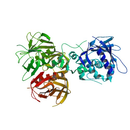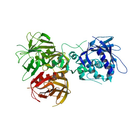
Browsing Toxins
Displaying toxin 3126 - 3150 of 3678 in total
| T3DB ID | Name CAS Number | Formula Weight | Structure | Type | Mechanism of Toxicity |
|---|---|---|---|---|---|
| T3D1819 | Selenium dioxide 7446-08-4 | O2Se 110.960 g/mol |  |
| Selenium readily substitutes for sulfur in biomolecules and in many biochemical reactions, especially when the concentration of selenium is high and the concentration ...more Number of Targets: 0 |
| T3D1821 | Selenium disulfide 7488-56-4 | S2Se 143.090 g/mol |  |
| Selenium readily substitutes for sulfur in biomolecules and in many biochemical reactions, especially when the concentration of selenium is high and the concentration ...more Number of Targets: 0 |
| T3D1822 | Selenium hexafluoride 7783-79-1 | F6Se 192.950 g/mol |  |
| Selenium readily substitutes for sulfur in biomolecules and in many biochemical reactions, especially when the concentration of selenium is high and the concentration ...more Number of Targets: 0 |
| T3D1823 | Selenium hexasulfide 75926-26-0 | SSe 111.030 g/mol |  |
| Selenium readily substitutes for sulfur in biomolecules and in many biochemical reactions, especially when the concentration of selenium is high and the concentration ...more Number of Targets: 0 |
| T3D1751 | Selenium oxybromide 7789-51-7 | Br2OSe 254.770 g/mol |  |
| Selenium readily substitutes for sulfur in biomolecules and in many biochemical reactions, especially when the concentration of selenium is high and the concentration ...more Number of Targets: 6 |
| T3D1824 | Selenium oxydichloride 7791-23-3 | Cl2OSe 165.870 g/mol |  |
| Selenium readily substitutes for sulfur in biomolecules and in many biochemical reactions, especially when the concentration of selenium is high and the concentration ...more Number of Targets: 0 |
| T3D1820 | Selenium Sulfide 7446-34-6 | SSe 111.030 g/mol |  |
| Selenium sulfide can be decomposed to selenium ions. Selenium readily substitutes for sulfur in biomolecules and in many biochemical reactions, especially when the con...more Number of Targets: 0 |
| T3D1825 | Selenium tetrachloride 10026-03-6 | Cl4Se 220.770 g/mol |  |
| Selenium readily substitutes for sulfur in biomolecules and in many biochemical reactions, especially when the concentration of selenium is high and the concentration ...more Number of Targets: 0 |
| T3D1826 | Selenium tetrafluoride 13465-66-2 | F4Se 154.950 g/mol |  |
| Selenium readily substitutes for sulfur in biomolecules and in many biochemical reactions, especially when the concentration of selenium is high and the concentration ...more Number of Targets: 0 |
| T3D1827 | Selenium trioxide 13768-86-0 | O3Se 126.960 g/mol |  |
| Selenium readily substitutes for sulfur in biomolecules and in many biochemical reactions, especially when the concentration of selenium is high and the concentration ...more Number of Targets: 0 |
| T3D1837 | Selenous acid 7783-00-8 | H2O3Se 128.970 g/mol |  |
| Selenium readily substitutes for sulfur in biomolecules and in many biochemical reactions, especially when the concentration of selenium is high and the concentration ...more Number of Targets: 0 |
| T3D4059 | Senecionine 130-01-8 | C18H25NO5 335.395 g/mol |  |
| Senecionine is classified as a pyrrolizidine alkaloid (PA). Unsaturated pyrrolizidine alkaloids are hepatotoxic, that is, damaging to the liver. PAs also cause hepatic...more Number of Targets: 0 |
| T3D2997 | Sertaconazole 99592-32-2 | C20H15Cl3N2OS 437.770 g/mol |  |
| Sertaconazole interacts with 14-α demethylase, a cytochrome P-450 enzyme necessary to convert lanosterol to ergosterol. As ergosterol is an essential component of the ...more Number of Targets: 0 |
| T3D2985 | Sertraline 79617-96-2 | C17H17Cl2N 306.230 g/mol |  |
| The exact mechanism of action sertraline is not fully known, but the drug appears to selectively inhibit the reuptake of serotonin at the presynaptic membrane. This re...more Number of Targets: 9 |
| T3D3921 | Sethoxydim 74051-80-2 | C17H29NO3S 327.482 g/mol |  |
| Not Available Number of Targets: 5 |
| T3D3029 | Sevoflurane 28523-86-6 | C4H3F7O 200.055 g/mol |  |
| Sevoflurane induces a reduction in junctional conductance by decreasing gap junction channel opening times and increasing gap junction channel closing times. Sevoflura...more Number of Targets: 8 |
| T3D2609 | Shiga toxin subunit A Not Available | Not Available 34813.360 g/mol |  |
| Shiga toxin causes the glycosidase cleavage of ribosomal eucaryotic 28S rRNA, resulting in inhibition of protein synthesis in susceptible cells. (L1767) Number of Targets: 1 |
| T3D3129 | Shiga toxin subunit B 75757-64-1 | Not Available 9743.070 g/mol |  |
| Shiga toxin causes the glycosidase cleavage of ribosomal eucaryotic 28S rRNA, resulting in inhibition of protein synthesis in susceptible cells. (L1767) Number of Targets: 1 |
| T3D2986 | Sibutramine 106650-56-0 | C17H26ClN 279.848 g/mol |  |
| Sibutramine produces its therapeutic effects by inhibition of norepinephrine (NE), serotonin (5-hydroxytryptamine, 5-HT), and to a lesser extent, dopamine reuptake at ...more Number of Targets: 6 |
| T3D1752 | Silicon tetrabromide 7789-66-4 | Br4Si 347.702 g/mol |  |
| Bromine is a powerful oxidizing agent and is able to release oxygen free radicals from the water in mucous membranes. These free radicals are also potent oxidizers and...more Number of Targets: 6 |
| T3D0214 | Silver 7440-22-4 | Ag 107.868 g/mol |  |
| Metallic silver is oxidized and may deposit in the tissues, causing arygria. The silver ion is known to inhibit glutathione peroxidase and NA+,K+-ATPase activity, resp...more Number of Targets: 18 |
| T3D1599 | Silver acetate 563-63-3 | C2H3AgO2 166.912 g/mol |  |
| Metallic silver is oxidized and may deposit in the tissues, causing arygria. The silver ion is known to inhibit glutathione peroxidase and NA+,K+-ATPase activity, disr...more Number of Targets: 17 |
| T3D1600 | Silver acetylide 7659-31-6 | C2HAg 132.898 g/mol |  |
| Metallic silver is oxidized and may deposit in the tissues, causing arygria. The silver ion is known to inhibit glutathione peroxidase and NA+,K+-ATPase activity, disr...more Number of Targets: 17 |
| T3D1601 | Silver azide 13863-88-2 | AgN3 149.888 g/mol |  |
| Metallic silver is oxidized and may deposit in the tissues, causing arygria. The silver ion is known to inhibit glutathione peroxidase and NA+,K+-ATPase activity, disr...more Number of Targets: 17 |
| T3D1717 | Silver bromate 7783-89-3 | AgBrO3 235.770 g/mol |  |
| Bromine is a powerful oxidizing agent and is able to release oxygen free radicals from the water in mucous membranes. These free radicals are also potent oxidizers and...more Number of Targets: 23 |